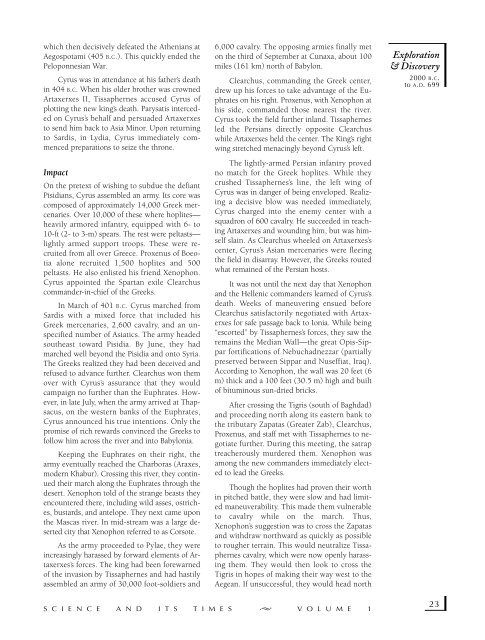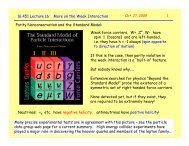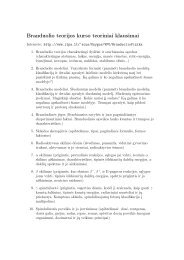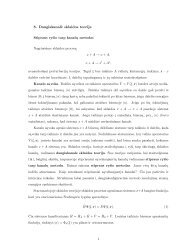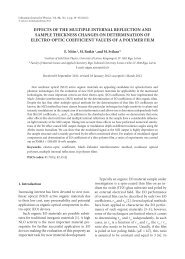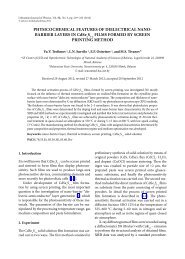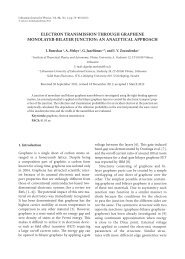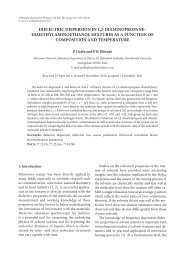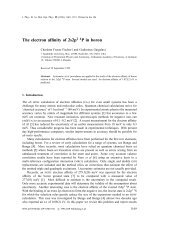Gale - Science and Its Times Vol 01 (2000 BC to AD 699).pdf
Gale - Science and Its Times Vol 01 (2000 BC to AD 699).pdf
Gale - Science and Its Times Vol 01 (2000 BC to AD 699).pdf
Create successful ePaper yourself
Turn your PDF publications into a flip-book with our unique Google optimized e-Paper software.
which then decisively defeated the Athenians at<br />
Aegospotami (405 B.C.). This quickly ended the<br />
Peloponnesian War.<br />
Cyrus was in attendance at his father’s death<br />
in 404 B.C. When his older brother was crowned<br />
Artaxerxes II, Tissaphernes accused Cyrus of<br />
plotting the new king’s death. Parysatis interceded<br />
on Cyrus’s behalf <strong>and</strong> persuaded Artaxerxes<br />
<strong>to</strong> send him back <strong>to</strong> Asia Minor. Upon returning<br />
<strong>to</strong> Sardis, in Lydia, Cyrus immediately commenced<br />
preparations <strong>to</strong> seize the throne.<br />
Impact<br />
On the pretext of wishing <strong>to</strong> subdue the defiant<br />
Pisidians, Cyrus assembled an army. <strong>Its</strong> core was<br />
composed of approximately 14,000 Greek mercenaries.<br />
Over 10,000 of these where hoplites—<br />
heavily armored infantry, equipped with 6- <strong>to</strong><br />
10-ft (2- <strong>to</strong> 3-m) spears. The rest were peltasts—<br />
lightly armed support troops. These were recruited<br />
from all over Greece. Proxenus of Boeotia<br />
alone recruited 1,500 hoplites <strong>and</strong> 500<br />
peltasts. He also enlisted his friend Xenophon.<br />
Cyrus appointed the Spartan exile Clearchus<br />
comm<strong>and</strong>er-in-chief of the Greeks.<br />
In March of 4<strong>01</strong> B.C. Cyrus marched from<br />
Sardis with a mixed force that included his<br />
Greek mercenaries, 2,600 cavalry, <strong>and</strong> an unspecified<br />
number of Asiatics. The army headed<br />
southeast <strong>to</strong>ward Pisidia. By June, they had<br />
marched well beyond the Pisidia <strong>and</strong> on<strong>to</strong> Syria.<br />
The Greeks realized they had been deceived <strong>and</strong><br />
refused <strong>to</strong> advance further. Clearchus won them<br />
over with Cyrus’s assurance that they would<br />
campaign no further than the Euphrates. However,<br />
in late July, when the army arrived at Thapsacus,<br />
on the western banks of the Euphrates,<br />
Cyrus announced his true intentions. Only the<br />
promise of rich rewards convinced the Greeks <strong>to</strong><br />
follow him across the river <strong>and</strong> in<strong>to</strong> Babylonia.<br />
Keeping the Euphrates on their right, the<br />
army eventually reached the Charboras (Araxes,<br />
modern Khabur). Crossing this river, they continued<br />
their march along the Euphrates through the<br />
desert. Xenophon <strong>to</strong>ld of the strange beasts they<br />
encountered there, including wild asses, ostriches,<br />
bustards, <strong>and</strong> antelope. They next came upon<br />
the Mascas river. In mid-stream was a large deserted<br />
city that Xenophon referred <strong>to</strong> as Corsote.<br />
As the army proceeded <strong>to</strong> Pylae, they were<br />
increasingly harassed by forward elements of Artaxerxes’s<br />
forces. The king had been forewarned<br />
of the invasion by Tissaphernes <strong>and</strong> had hastily<br />
assembled an army of 30,000 foot-soldiers <strong>and</strong><br />
6,000 cavalry. The opposing armies finally met<br />
on the third of September at Cunaxa, about 100<br />
miles (161 km) north of Babylon.<br />
Clearchus, comm<strong>and</strong>ing the Greek center,<br />
drew up his forces <strong>to</strong> take advantage of the Euphrates<br />
on his right. Proxenus, with Xenophon at<br />
his side, comm<strong>and</strong>ed those nearest the river.<br />
Cyrus <strong>to</strong>ok the field further inl<strong>and</strong>. Tissaphernes<br />
led the Persians directly opposite Clearchus<br />
while Artaxerxes held the center. The King’s right<br />
wing stretched menacingly beyond Cyrus’s left.<br />
The lightly-armed Persian infantry proved<br />
no match for the Greek hoplites. While they<br />
crushed Tissaphernes’s line, the left wing of<br />
Cyrus was in danger of being enveloped. Realizing<br />
a decisive blow was needed immediately,<br />
Cyrus charged in<strong>to</strong> the enemy center with a<br />
squadron of 600 cavalry. He succeeded in reaching<br />
Artaxerxes <strong>and</strong> wounding him, but was himself<br />
slain. As Clearchus wheeled on Artaxerxes’s<br />
center, Cyrus’s Asian mercenaries were fleeing<br />
the field in disarray. However, the Greeks routed<br />
what remained of the Persian hosts.<br />
It was not until the next day that Xenophon<br />
<strong>and</strong> the Hellenic comm<strong>and</strong>ers learned of Cyrus’s<br />
death. Weeks of maneuvering ensued before<br />
Clearchus satisfac<strong>to</strong>rily negotiated with Artaxerxes<br />
for safe passage back <strong>to</strong> Ionia. While being<br />
“escorted” by Tissaphernes’s forces, they saw the<br />
remains the Median Wall—the great Opis-Sippar<br />
fortifications of Nebuchadnezzar (partially<br />
preserved between Sippar <strong>and</strong> Nuseffiat, Iraq).<br />
According <strong>to</strong> Xenophon, the wall was 20 feet (6<br />
m) thick <strong>and</strong> a 100 feet (30.5 m) high <strong>and</strong> built<br />
of bituminous sun-dried bricks.<br />
After crossing the Tigris (south of Baghdad)<br />
<strong>and</strong> proceeding north along its eastern bank <strong>to</strong><br />
the tributary Zapatas (Greater Zab), Clearchus,<br />
Proxenus, <strong>and</strong> staff met with Tissaphernes <strong>to</strong> negotiate<br />
further. During this meeting, the satrap<br />
treacherously murdered them. Xenophon was<br />
among the new comm<strong>and</strong>ers immediately elected<br />
<strong>to</strong> lead the Greeks.<br />
Though the hoplites had proven their worth<br />
in pitched battle, they were slow <strong>and</strong> had limited<br />
maneuverability. This made them vulnerable<br />
<strong>to</strong> cavalry while on the march. Thus,<br />
Xenophon’s suggestion was <strong>to</strong> cross the Zapatas<br />
<strong>and</strong> withdraw northward as quickly as possible<br />
<strong>to</strong> rougher terrain. This would neutralize Tissaphernes<br />
cavalry, which were now openly harassing<br />
them. They would then look <strong>to</strong> cross the<br />
Tigris in hopes of making their way west <strong>to</strong> the<br />
Aegean. If unsuccessful, they would head north<br />
Exploration<br />
& Discovery<br />
<strong>2000</strong> B.C.<br />
<strong>to</strong> A.D. <strong>699</strong><br />
S C I E N C E A N D I T S T I M E S V O L U M E 1<br />
23


